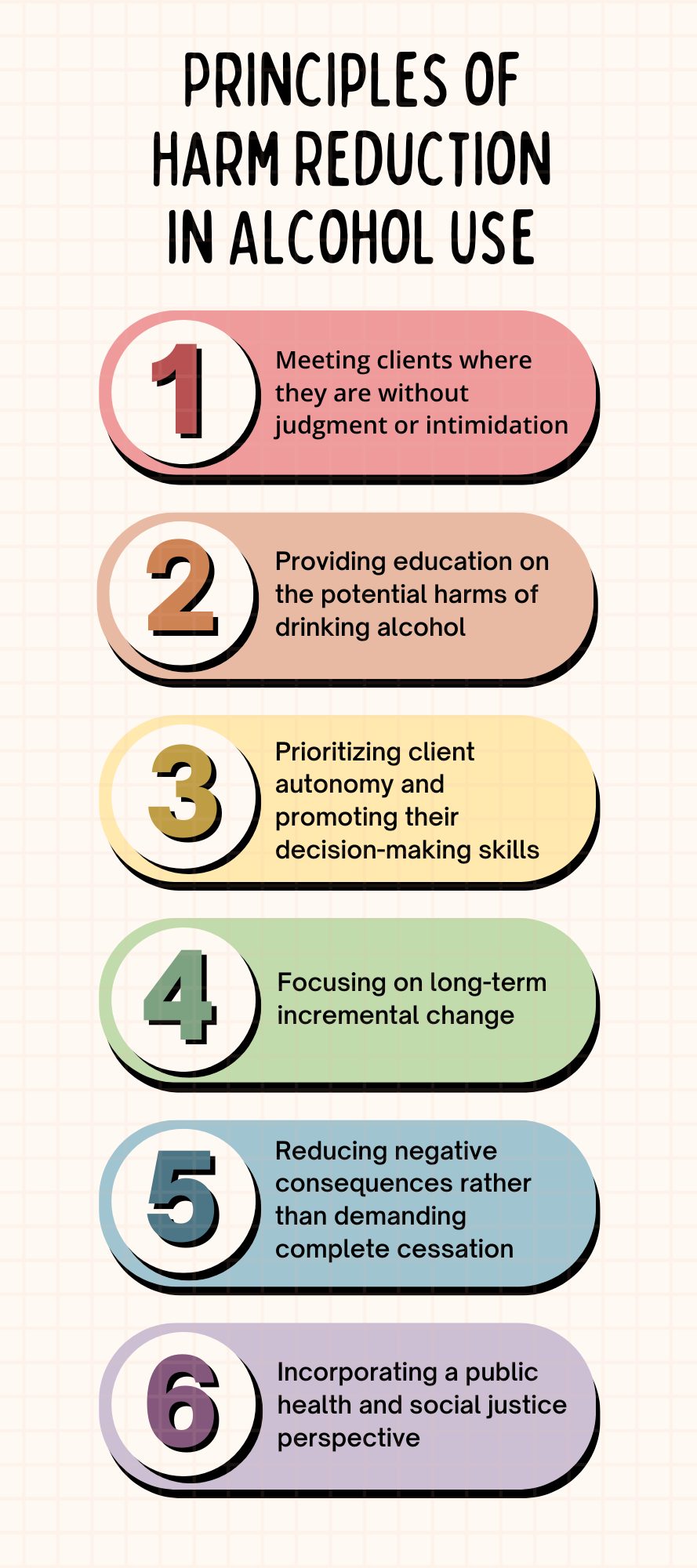Blog > Treatment Strategies > Harm Reduction and Alcohol
Harm Reduction and Alcohol:
A Practical Approach for Behavioral Health Clinicians

Last Updated: March 31, 2025


What You'll Learn
-
The core principles of harm reduction and how they apply to alcohol use treatment
-
The limitations of abstinence-only models and how they may impact client outcomes
-
Practical harm reduction strategies clinicians can use in therapy sessions
-
How to assess which clients may benefit more from harm reduction vs. abstinence
Mental health professionals know that there is no one-size-fits-all approach for substance use conditions and other psychological disorders. Each person requires an individualized treatment plan that incorporates the unique needs, stressors, supports, and goals of the person being impacted. Too often, though, with substance use disorders, abstinence is the only recommended target, which limits the recovery path for many.
Instead, therapists and the clients they treat should consider an alternative approach called harm reduction. Although harm reduction may not be the best course for all, it offers another treatment plan that may produce good outcomes without an overly rigid set of expectations. If abstinence seems too restrictive, harm reduction could be an option to consider.
Issues with Abstinence-Only Models
Before understanding the principles of harm reduction, it is paramount to grasp the impact of the alternative - abstinence. In an abstinence-centered position to substance use, the client can never drink alcohol again if they wish to accomplish their goal. Any use of alcohol is discouraged with any drinking being associated with negative and unwanted terms like:
- Relapse
- Regression
- Failure
- Slip
- Setback
- Falling off the wagon
Drinking alcohol or having cravings to drink in an abstinence model creates fear, shame, guilt, and disappointment. The client could feel these internally or worry that others are standing in judgment. These unwanted feelings can lead to people hiding their thoughts or actions and actively lying to others to maintain the impression of sobriety and “staying clean,” which signifies the duration of their recovery.
Clearly, abstinence is a method that works well for many people and has been historically helpful. For more than 70 years, abstinence has been the basis for recovery models like Alcoholics Anonymous (AA), but in the 2020s, other models may feel more realistic and contemporary.
Take the Quiz!
Is Harm Reduction a Worthwhile Recovery Approach?
Take this short quiz to help determine whether a harm reduction approach may be a valuable and appropriate fit for your clients navigating alcohol use.
Principles of Harm Reduction in Alcohol Use
Harm reduction presents as one of those alternatives. Rather than supporting the polarized view that all alcohol is bad and all abstinence is good, harm reduction is a nuanced concept that recognizes the shades of grey in alcohol use.
When using a harm reduction perspective, clients can drink alcohol. The amount and frequency of consumption will be discussed and analyzed based on past history, current trends, and future goals.
In harm reduction, therapists would be more concerned with lowering the negative impact of alcohol in their client’s lives, not simply cutting it all out. Harm reduction centers on the ideas of:
- Meeting clients where they are without judgment or intimidation
- Providing education on the potential harms of drinking alcohol
- Prioritizing client autonomy and promoting their decision-making skills
- Focusing on long-term incremental change
- Reducing negative consequences rather than demanding complete cessation
- Incorporating a public health and social justice perspective
Harm reduction presents many paths towards health. Some clients may determine that drinking some level of alcohol daily, weekly, or monthly is an allowable act. Some other clients may come to the conclusion that abstinence is the only appropriate path for them, but the process of coming to that decision will be a collaborative effort, rather than feeling like their therapist or society are demanding that choice.
Freedom of choice is a cornerstone of harm reduction that helps make the practice sustainable over the course of months and years. Even better, harm reduction offers flexibility, so if one strategy is not working, another one can be adopted.

Harm Reduction Strategies for Alcohol Use
The best harm reduction strategies for alcohol use begin with a clear and honest picture of past use and the consequences of this use.Therapists should work to complete a comprehensive review of a person’s relationship with alcohol to understand its apparent risks and benefits. This history should include:
- When drinking started
- The early benefits of alcohol use
- The later risks and harms
- The interaction between amount consumed and unwanted consequences
- The perceived risks of abstinence
Armed with this information, the therapist and client can explore possible harm reduction strategies like:
- Setting limits and tracking consumption. Limits may involve lowering the frequency of drinking or the amount consumed per drinking session.
- Measuring drinks. One of the simplest strategies is to measure and document the alcohol being consumed. Many clients may report drinking a certain number of drinks but have no idea of the true alcohol content in those drinks. Increased data and accountability can change the dynamic.
- Changing the pace. If the client is a binge drinker, they may consume many drinks in a short amount of time. Shifting to a slower, methodical approach can adjust their relationship with alcohol.
- Adjusting food and water habits. Adding new routines involving food and water intake before, during, and after drinking alcohol can impact the outcomes. For example, planning to drink two glasses of water for every alcoholic drink can alter the results
- Exploring medications. Prescription medications like Campral (acamprosate), Disulfiram, and Vivitrol (naltrexone) trigger effects that decrease the desire to drink. For clients who want to preemptively reduce harm, medication options could be valuable.
- Adding/ adjusting support groups. People already in therapy could receive extra benefit by seeking additional resources or joining a support group based on harm reduction beliefs like Moderation Management, Self-Management and Recovery Training (SMART), Women for Sobriety
- Utilizing additional tools. More and more harm reduction techniques are becoming available and acceptable. Clients should consider using designated drivers, apps and services to track their blood alcohol content (BAC), learning about overdose prevention, and excluding alcohol from the home.
Like so many other situations, harm reduction strategies for alcohol are not universal. Most clients will benefit from a blended, personalized path. Establish expectations, study the effectiveness, and reassess as needed. Staying flexible and responsive will help to decrease the feelings of shame and guilt common with abstinence-only plans.

Comparing Outcomes: Harm Reduction vs. Abstinence
On the surface, abstinence models of alcohol use make sense because they present the best way to eliminate all alcohol-related risks. In the real world, though, they have the ability to create an unhealthy, all-or-nothing mindset that may conflict with the individual and their goals.
Harm reduction presents a meaningful alternative to continued alcohol consumption. With harm reduction strategies meant to decrease, not eliminate, drinking, a person can experience health benefits like:
- Lower risks of developing an alcohol use disorder
- Improved mental health status with lower incidence of depression and anxiety
- Improve blood pressure, liver function, and liver disease
- Lower health care needs and expenses
- Increase positive effects of medications
Again, the safest approach is not drinking any alcohol, but harm reduction’s benefits are well-documented and more accessible for many people throughout their lifespan.
Practical Considerations for Clinicians
For clinicians, the practical consideration becomes establishing which clients are appropriate for abstinence and which are appropriate for harm reduction. As expected, the answer is not straightforward and could require several instances of trial and error to know with certainty.
At the beginning, it’s essential for clients to acknowledge and accept their options and make an informed decision. When a person feels forced into a position, their health and well-being may feel threatened. A therapist creates an ethical dilemma anytime they recommend a treatment plan based on their personal opinions, rather than the client’s best interests.
When exploring the options, the therapist and client should consider:
- Current alcohol consumption
- Current or future health effects
- Views of abstinence and harm reduction
- Previous successes or setbacks with each
- Family and friend’s stance on alcohol
- Ability to regulate self after drinking
- Long-term vs. short-term needs and wants
Whatever the decision, frequent evaluation, reassessment, and consultation with other professionals are essential.
Documenting Harm Reduction Strategies with ICANotes
Implementing a harm reduction approach requires careful planning, collaborative goal setting, and consistent monitoring—all of which depend on accurate and thorough documentation. The ICANotes Behavioral Health EHR offers powerful tools that enable clinicians to seamlessly incorporate harm reduction strategies into a client’s treatment plan while maintaining a clear clinical narrative.
With ICANotes, behavioral health clinicians can:
-
Document collaborative treatment goals that reflect the client’s preferences and readiness for change, including specific harm reduction targets such as reduced frequency or quantity of alcohol use.
-
Track progress and patterns over time using customizable templates that allow for consistent updates to drinking behavior, medication adherence, and use of harm reduction tools like BAC trackers or support group attendance.
-
Record motivational interviewing outcomes and psychoeducation efforts that support client autonomy and informed decision-making.
-
Capture nuanced risk assessments around alcohol use and document interventions that mitigate those risks, such as safety planning or scheduling sober support systems.
-
Easily update treatment plans as clients adjust their goals or strategies, helping clinicians stay responsive to each person’s evolving relationship with alcohol.
- Generate clear, compliance-ready progress notes that reflect harm reduction principles without pathologizing occasional use or setbacks.
By supporting structured, flexible, and client-centered documentation, ICANotes empowers clinicians to practice ethically and effectively—whether clients are pursuing abstinence, moderation, or simply reducing harm.
Interested in seeing how ICANotes can support your harm reduction practice? Start your 30-day free trial today and experience how behavioral health-specific documentation can streamline your workflow and improve client care.
Conclusion
In the end, the best a therapist can do is offer a client-centered, flexible approach. For therapists using a predominantly, abstinence-only practice, considering more harm reduction strategies can empower clients to view themselves and their drinking in different ways. It can also open up therapy to many people who see abstinence as the only step forward.
When abstinence does not seem realistic, harm reduction could be the best option.
Get Your Free 30-Day Trial (no credit card required!)
Related Posts
Eric Patterson, MSCP, NCC, LPC, is a professional counselor who has been working for over a decade to help children, adolescents, and adults in western Pennsylvania reach their goals and improve their well-being.
Along the way, Eric worked as a collaborating investigator for the field trials of the DSM-5 and completed an agreement to provide mental health treatment to underserved communities with the National Health Service Corp.







